Teaching. Acute
Until 1902 the sick poor of Hammersmith had been sent to the Fulham Infirmary, which was under the control of the Joint Board of Guardians of the Poor of Fulham and Hammersmith. In 1902 a separate Board of Guardians was established for Hammersmith.
The Board immediately decided to build its own workhouse and infirmary and a 14 acre site, surrounded by playing fields, was purchased for £14,500 from the Ecclesiastical Commissioners. It was adjacent to Wormwood Scrubs Prison, the only other building in the vicinity. However, before building work could begin, a temporary corrugated iron hut had to be erected on the site for use as a smallpox hospital (an epidemic had broken out in the winter of 1901-1902).
In July 1903 the foundation stone for the instituttion was laid by Walter London, M.P., the President of the Local Government Board.
The Hammersmith Institution was officially opened on 5th December, 1905, by Princess Henry of Battenberg. The workhouse could accommodate 428 destitute poor and the Infirmary 330 patients.
The site measured about 830 ft (250 metres) from east to west and 730 ft (220 metres) from north to south. The Infirmary occupied the southern part, along Du Cane Road, based on a central administration building, which contained committee rooms, the Medical Officer's residence, a dispensary, the central kitchen, larders and storerooms, staff dining rooms, linen rooms and sleeping quarters for the domestic staff. It was flanked by the pavilion ward blocks, with male patients on the east side and female on the west. The 3-storey ward blocks lay north and south of a long main corridor, which ran east to west. (The plan allowed for four such double pavilions, but only two had been built. The central portions of the lower storeys of the remaining two had also been built and contained 1- and 2-bedded rooms for special cases.) Each block could accommodate 150 patients. Each ward contained 24 beds and a nurses' duty room, a 1-bedded room, a bathroom and WC, a linen room and a storeroom. To the west of the main buildings was a 10-bedded ward for maternity cases, with a resident midwife. Separate receiving blocks were provided for males and females, located adjacent to the corresponding pavilions. The operating theatre was in a detached block to the north of the main corridor, linked to it by a short corridor. The buildings had central heating and were lighted throughout by electricity.
The workhouse occupied the northern part, while the laundry, the boiler house, the stone-breaking shed (the Hammersmith Hospital Annual Report for 1957-58 illustrates a granite block, part of the last consignment to the workhouse for breaking up by the inmates of the casual ward), the corn mill and the workshops for carpenters, joiners, plumbers, smiths and wood choppers were located in the centre of the site. Adjoining the workshop block were the stables and the mortuary.
Immediately on opening, there was an outcry about the cost of the Infirmary building (£261,000 - a huge sum in those days) and its lavishness. The vestibule was paved with mosaic and was surrounded with a dado of the most expensive encaustic tiles. The dining hall was 'of baronial splendour'. The press dubbed it the 'Paupers' Paradise' and the 'Palace on the Scrubs'.
The Infirmary was, in fact, better equipped than most voluntary hospitals and had a more highly trained medical and nursing staff. There was a separate Nurses' Home and a Training School for Nurses. The nursing staff consisted of 41 nurses (10 of whom were trained) and 30 probationers, and one Receiving Ward nurse. All lived in the Nurses' Home, where they each had a separate bedroom - a revolutionary step at that time. Nurses worked from 7 o'clock in the morning until half past 8 in the evening, with three half-hour breaks for meals. (Later, they were allowed one off-duty afternoon a week and, later still, one day off each week.) Ward Sisters earmed £36 a year.
By 1911 the nursing staff had increased to 60. There were separate wards for medical, surgical, isolation, plaster, tuberculosis and maternity cases, as well as one for children.
At the outbreak of WW1 the leading orthopaedic surgeon Sir Robert Jones (1857-1933) was appointed as Inspector of Military Orthopaedics. It was the Army tradition at this time that all military hospitals should 'evacuate' patients as soon as they could be moved, so beds were freed for the newly wounded. Thus, patients were constantly transferred from one hospital to another, and treated by different surgeons. Sir Robert proposed that there should be a military hospital where the wounded would stay until they were fit to be returned to the Army or where they could be trained in some craft or trade so they could earn a living in civilian life. This hospital should have at least 800 beds.
In 1915 the War Office approached the Hammersmith Board of Guardians with a view of using their Institution for this purpose, probably because it was one of the most modern and best equipped. The Board of Guardians agreed, and its patients and inmates were transferred elsewhere.
In February 1916 the workhouse and its infirmary became the Military Orthopaedic Hospital, Shepherd's Bush (it was later renamed the Special Surgical Hospital), under the personal supervision of Col. Sir Robert Jones. It had 800 beds (later in the war, another 200 patients were billeted locally in requisitioned houses, attending the Hospital every day).
The Hospital was intended to serve as a model for other orthopaedic centres. The British Red Cross Society and ex-King Manuel II of Portugal (1889-1932) were enthusiastic supporters. The Joint War Committee donated £10,000 towards the cost of operating theatres and treatment departments - hydrotherapy, electrotherapy, massage and plaster - while King Manuel provided the gymnasium building.
'Curative workshops' were established as occupational therapy for the patients and the Hospital became the 'first experimental hospital in training the disabled'. Many patients were trained or employed in the workshops. In the orthopaedic workshop, the men learned to make surgical splints and, later, boots and shoes, especially surgical boots. Training was given in plumbing, electrical work, tin and copper work, as well as in engineering (general and operating theatre appliances). There were workshops in felting, enamelling, tailoring, cigarette-making, carpentry, and the making of fancy leather goods. Metal grinding and polishing were taught in a machine shop. There was even a photographic dark room.
After the war the Hospital was transferred to the control of the Ministry of Pensions in July 1919. By this time the surgeons were dealing not with open wounds, but with the sequelae of injuries - ankylosed joints and flail limbs, malunited or ununited fractures and restricted joint movement - which required corrective operations or bone grafting. In 1921 some 4,000 officers and men were treated in the Hospital; 2,494 operations had been performed in that year alone, and 101,596 out-patients had been seen.
In 1922 it was suggested that the Special Surgical Hospital move to the vacated South African Military Hospital in Richmond Park, but the orthopaedic surgeons objected to this, on the grounds that continuity of care would be disrupted. Surgeons based at one site were able to discuss problem cases with their colleagues, but this would be extremely difficult if in-patients were in Richmond Park and out-patients in central London.
From 1916 to 1919, when the Hospital was military, the Hammersmith Board of Guardians had received no rent. In 1919, when it was handed over to the Ministry of Pensions, the Board asked for, and received, a rent of £8,000 a year. However, by 1921, the Board found that the outgoings to meet the expenses on the buildings were £9,300 - some £1,300 more than they were receiving. The Board suggested to the Ministry that the rent be increased to £10,000 a year, but received no response. The Ministry was then given notice to quit unless it paid £14,000 a year. The Ministry offered £12,000 but this was refused. In April 1925 the site was finally returned to the Hammersmith Board of Guardians; the remaining patients were transferred to Queen Mary's Hospital, Roehampton.
In 1930, when the Boards of Guardians were abolished, the Institution came under the control of the LCC, who renamed it the Hammersmith Hospital. The Infirmary had 300 beds, but the workhouse, which could accommodate 575 inmates, was progressively merged with it to provide more accommodation for the sick. The nursing staff was increased to 200.
In 1934 a Casualty Department and Out-Patients Department opened in a new building.
The Hospital was chosen to become the site of the new Postgraduate Medical School of the University of London. The Treasury and the LCC agreed to each provide £250,000 towards the cost of the new building and its equipment. A Royal Charter was granted to the School on 10th July 1931. The foundation stone was laid by Neville Chamberlain, Chancellor of the Exchequer, in July 1933 and the Royal Postgraduate Medical School was officially opened on 13th May, 1935, by King George V. It was the only general hospital dedicated to postgraduate teaching.
The LCC remained in administrative control of the whole Hospital and was responsible for the chronically ill patients in the northern section (the former workhouse building), while the School took on the 458 acute beds in the southern part (the former infirmary), and the teaching and research activities.In 1939 it was agreed that the School would have all the 680 beds for teaching purposes but, at the outbreak of WW2, the top floor wards were closed because of the risk of bombing, and many postgraduate students departed to join the Forces. The main operating theatres were also closed, and improvised ones established in the basement. Many of the staff, especially the nurses, were seconded to hospitals far from London. However, when the bombing raids failed to materialise early in the war, postgraduate student numbers increased. The Radiotherapy Unit belonging to the Medical Research Council (MRC) moved to the site (where it has remained ever since) and a shaft was sunk in which to bury the radium to protect it from bombing.
During the war the Hospital treated a large number of air-raid casualties, which were transferred to its advanced base hospitals in Hillingdon and Harefield. Since it was not in central London, many of the wounded it received were those who had been dug out of bombed buildings at a late stage, often suffering from crush injuries. Many subsequently developed renal failure. The effects of crush syndrome and renal failure were subsequently published in 1941. A renal unit was later established.
The buildings were damaged by blasts from bombs on several occasions, and in one raid the Refectory was completely destroyed. A special unit was set aside for Czech soldiers and airmen, who were visited by the exiled President and Madame Benes. In January 1941 the TB Dispensary belonging to Hammersmith Borough Council was destroyed by bombs, and the service was re-established at the Hospital.
After the war a Premature Baby Unit was established in 1947, which had 20 cots and, for mothers staying at night, 5 bedrooms and a sitting room.
The Hospital joined the NHS in 1948 as a teaching hospital linked to the West London Hospital and St Mark's Hospital.
A ward of 27 beds for TB patients opened, with additional beds, staffed by Hammersmith nurses, at St Charles' Hospital. In 1950 a Metabolic Unit opened. It had 8 beds and dietary and laboratory facilities.
In 1951 the staff restaurant was rebuilt and officially opened by Herbert Morrison, M.P., the Secretary of State for Foreign Affairs, who had been closely associated with the administration of the Hospital. The restaurant had a seating capacity of 450, with waitress service available on the ground floor and cafeteria service on the upper floor. The central kitchen prepared about 2,000 midday meals for patients and staff.
In the same year a single-storey building was erected for the Blood Transfusion Research Unit. St Helena's Recovery Home, for post-operative patients, opened in Cricklewood. In October 1952 a new building opened for the Obstetric and Gynaecological Out-Patients Department.
In 1955 a new block was built for the MRC Radiotherapy Unit, which had expanded considerably since it arrived in 1942. The new building had three floors (the Hospital later added another one) and contained research laboratories and two large machines - an 8-million-volt linear accelerator (the first machine of its kind designed to be used for the treatment of patients) and a £750,000 45-inch medical cyclotron, which produced radio-isotopes and an intense beam of high speed neutrons for use in medical research.
By the mid 1950s the Hospital had 694 beds and the nursing staff had increased to 600. By 1959, when the Hospital had 697 beds (including those at St Helena's), there were about 700 nurses (double the number employed in 1952). The cost of an in-patient per week was £34 14s 5d (£34.72), compared to £32 8s 11d (£32.45) the previous year.
The Postgraduate Medical School was rebuilt by the University of London at a cost of £93,000.
In 1957, after negotiations for many years, the Board of Governors finally persuaded the War Office to discontinue using the firing range on ground immediately to the north of the Hospital premises, thus removing one of the most disturbing features of the Hospital.
In 1962 smoking was forbidden in the maternity wards, during doctors' rounds and after lights were put out in the evening.
Nurses living in Hammersmith House and occupying bedrooms facing Wormwood Scrubs Prison found they were being kept awake by the very bright flood-lighting along the prison perimeter, installed after the spy George Blake escaped in 1966.
The Commonwealth Building was opened in May 1966 by Queen Elizabeth II. Originally planned to have 8 floors, additional funds gifted by the Wellcome Trust and the Max Rayne Foundation enabled two extra floors to be added. It housed the postgraduate medical school, the Wellcome Library and research departments. The £1.25m cost of the building had been paid for mostly by grants from Commonwealth countries, with substantial contributions from various organisation, industrial firms and individuals in the U.K.
By this time the Hospital was an extraordinary mix of ancient and modern buildings (some temporary). Hammersmith House, the Nurses' Home built by the LCC, provided accommodation only for 326 nurses with the remainder (329) having to live off-site. The medical staff residences were truly horrendous, with barely any facilities, but the prestige of working at the Hospital enabled it to keep its training posts filled.
In 1974, following a major reorganisation of the NHS, the Hospital came under the control of the North Hammersmith (Teaching) District Health Authority, part of the North West Thames Regional Health Authority. By 1976 plans were being made to relocate Queen Charlotte's Hospital to the Du Cane Road site.
In 1982, after another reorganisation, the Hospital was constituted a Special Health Authority but, in 1984, both Hospitals were merged under one Regional Health Authority - the Hammersmith and Queen Charlotte's Special Health Authority.
In 1994, following yet another reorganisation,the Hospital became part of the Hammersmith NHS Trust - a merger with Charing Cross Hospital, Queen Charlotte's and Chelsea Hospitals, and Acton Hospital.
In 1994 the Hospital was the first in Europe to use filmless X-rays. In 1997 the Royal Postgraduate Medical School became part of Imperial College.
At the end of 2000 Queen Charlotte's and Chelsea Hospital moved from its Goldhawk Road site to purpose-built premises on the Du Cane Road site.
In October 2007 the Hammersmith NHS Trust and St Mary's NHS Trust merged, forming a partnership with the Faculty of Medicine at Imperial College London.
Present status (December 2009)
The Hospital is now part of the Imperial College Healthcare NHS Trust. The largest NHS Trust in the United Kingdom, it includes Charing Cross Hospital, Hammersmith Hospital, Queen Charlotte's and Chelsea Hospital, St Mary's Hospital and the Western Eye Hospital.
UPDATE: July 2017
On 10th September 2014 the Accident & Emergency Department closed. It was replaced by a 24-hour Urgent Care Centre.
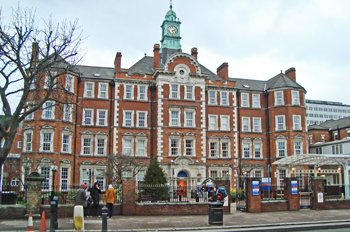
The administration block of the former Infirmary on the north side of Du Cane Road.
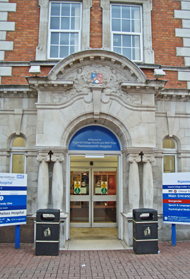

The ornate main entrance to the Southside block ('the Palace on the Scrubs') (left). A sculpture entitled The Circle of Life by Sarah Tombs, commissioned by the Hammerwmith Arts Committee and unveiled in 1993.
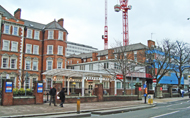

The main entrance to the Accident and Emergency Department in front of B block (left). The Accident and Emergency Department looks somewhat prefabricated (right).

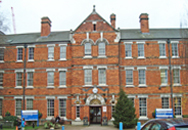
The administration building of the former workhouse was once in the centre of the range of workhouse buildings. It is now the Northside block. The 3-storey workhouse pavilions (two for males in the east and two for females in the west) could each accommodate 100 inmates.
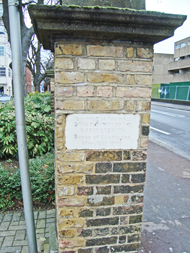
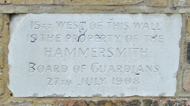
At the southwest cormer of the site is a masonry plaque dated 1908. It claims the land 15ft west of the wall is the property of the Hammersmith Board of Guardians.
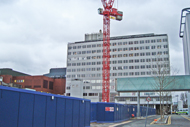
The Commonwealth Building, which opened in 1966.

The 5-storey Queen Charlotte's and Chelsea Hospital opened in 2000, built at a cost of £14m. It is on the corner of Du Cane Road and Artillery Lane, the narrow lane that runs between Wormwood Scrubs Prison and the Hospital site.
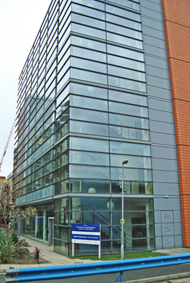

The Wolfson and Weston Research Centre for Family Health. The 6-storey research building, part of Imperial College, opened in 2001 at a cost of £10m.
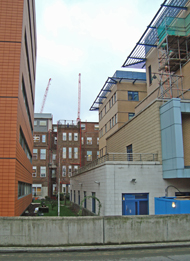
The old and the new - the Wolfson and Weston Research Centre building on the left, and Queen Charlotte's and Chelsea Hospital on the right, frame the Southside building of the former Infirmary.
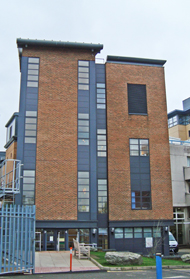
The £5.6m 14-bedded Catherine Lewis Centre for cancer treatment opened in 2002.


The main entrance to the Catherine Lewis and Garry Weston Centre Centre (left) and a small garden beside the building (right).
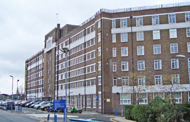
The former Nurses' Home, Hammersmith House, as seen from the south.
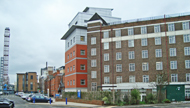
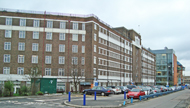
A new £20m 5-storey Renal Building opened in 2005. Located at the north end of Hammersmith House, it contains four wards - two with 29 beds and two with 21 beds (left). Hammersmith House from the north (right).
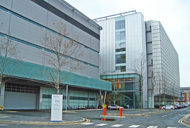
The £60m Burlington Danes Medical Research Facility, built on the former site of the adjacent Burlington Danes Academy, opened in 2006. It comprises two buildings; one houses the Clinical Imaging Centre, with research staff from Imperial College, the MRC and GlaxoSmithKline, and the other the Wolfson Neuroscience Laboratories.
(Author unstated) 1921 Reports by the Joint War Committee and the Joint War Finance Committee of the British Red Cross Society and the Order of St John of Jerusalem in England on Voluntary Aid Rendered to the Sick and Wounded at Home and Abroad and to British Prisoners of War, 1914-1919. London, HMSO (reprinted in facsimile, 2009. The Naval and Military Press Ltd in association with the Imperial War Museum), pp 249-253.
(Author unstated) 1922 The Special Surgical Hospital, Shepherd's Bush. British Medical Journal 1 (3196), 530.
(Author unstated) 1955 Hammersmith Hospital and the Postgraduate Medical School of London. A Short History. 1905-1955. London, Hammersmith Hospital.
Booth CC 1985 Medical science and technology at the Royal Postgraduate Medical School: the first 50 years. British Medical Journal (Clin Res Ed) 291 (6511), 1771-1779.
McCrae Aitken D 1922 The Orthopaedic Hospital of the Ministry of Pensions: an extravagant economy. British Medical Journal 1 (3191), 328.
https://en.wikipedia.org
https://paperspast.natlib.govt.nz
https://wellcomeimages.org
www.1914-1918.net
www.aim25.ac.uk
www.centenarynews.com
www.electives.net
www.flickr.com
www.friendsofhammersmithhospital.org.uk
www.geograph.org.uk
www.imperial.nhs.uk
www.indyrs.co.uk
www.lbhf.gov.uk
www.pastscape.org.uk
www.redcross.org.uk
www.sciencemuseum.org.uk (1)
www.sciencemuseum.org.uk (2)
www.workhouses.org.uk
Return to home page